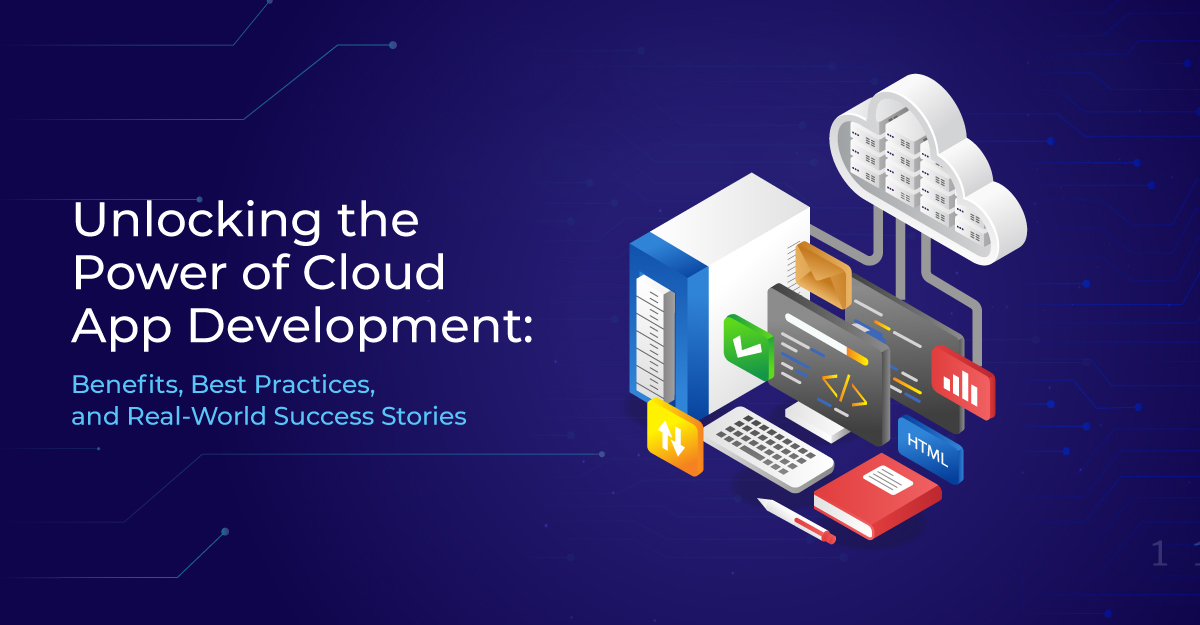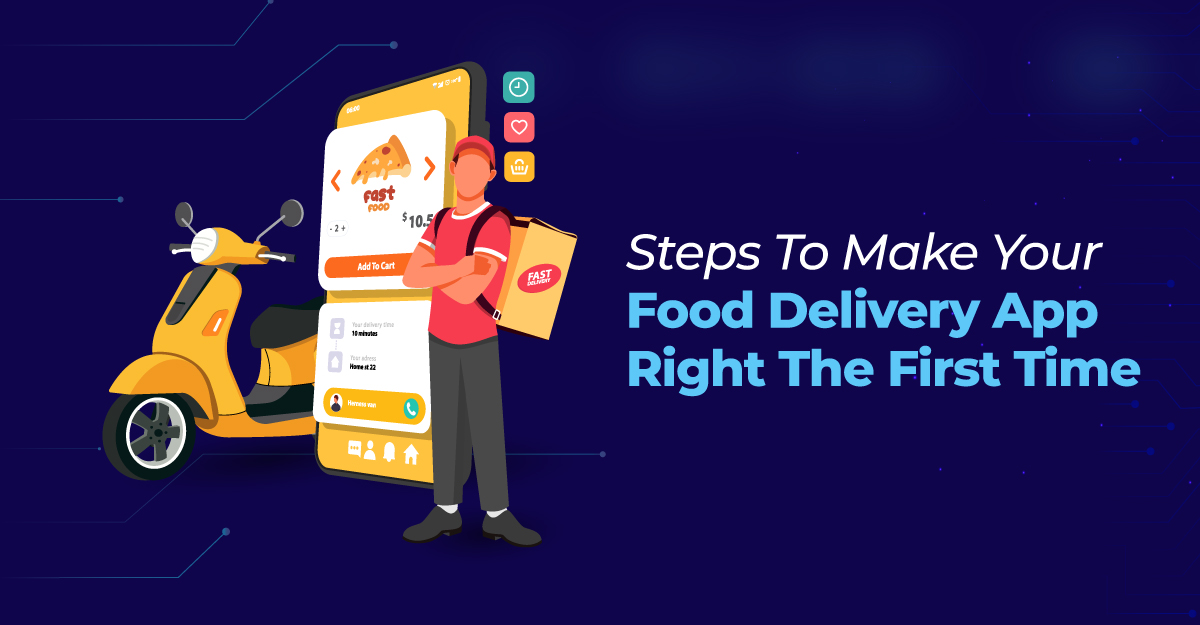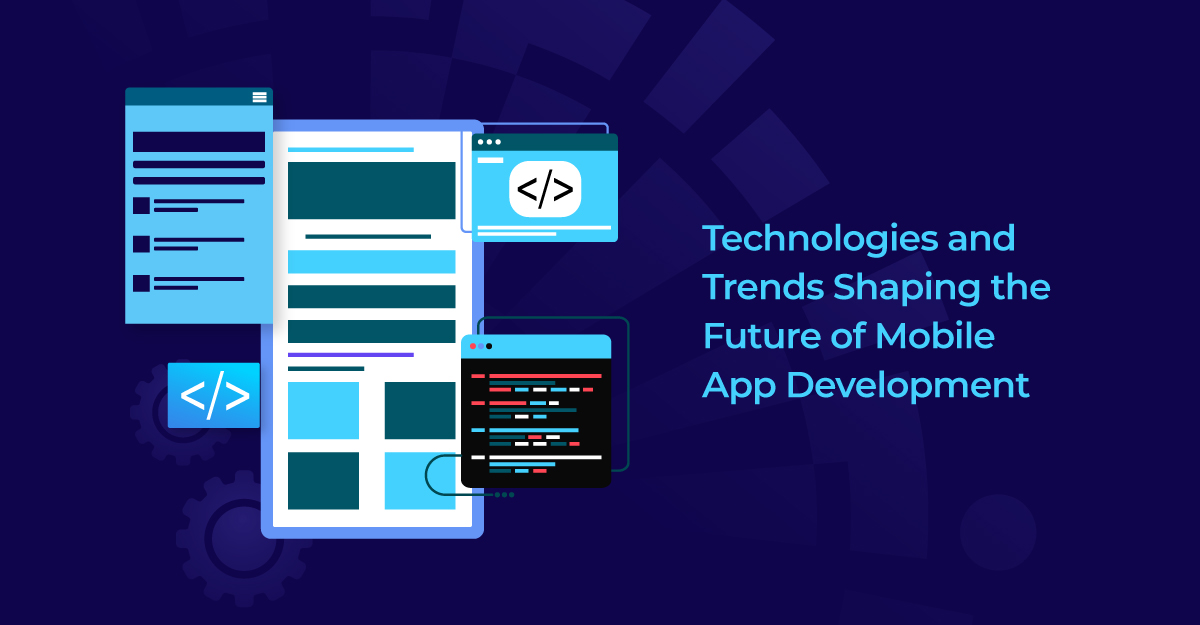There has been a sharp rise in cloud application development as a result of the demand for cloud-based apps. A cloud-based application or service is currently used by almost everyone, and enterprises have increased their usage. By developing Cloud services for their target market, startups should take action to profit from this trend. Read this article through to the end to learn how to construct a web-based application.
What Is Cloud Application Development?
It is the process of developing software that runs on cloud computing platforms. Another benefit is that you don't have to download internet-enabled devices to get access to cloud-based solutions. Cloud developers use a range of development tools and programming languages like Node.JS app development, Ruby on Rails, Python, and Java. Cloud-based apps are especially relevant for apps that provide real-time interaction between users, such as sharing their live location and communicating in real-time in on-demand delivery and movement apps. Data validation, data transfer, and user account ID are all the information about the user and app that has been stored in Cloud solutions.
Cloud App Development And Key Differences
Deeper communication between programmers, data architects, designers, and QA managers are necessary for cloud application development. The various cloud computing systems, including AWS, Microsoft Azure, Force.com, Apache CloudStack, and others, must be understood by developers. Developers also need to think about additional connectivity for CDNs and APIs. The final solution should also be versatile and expandable, as businesses like to keep their data on the cloud because it is simple to expand even temporarily. The most crucial information is that cloud-based programs can be as big as you want them to be, but cloud hosting costs money. Priorities for development should include condensing user requests, reducing data size, and addressing cloud security threats.
Tools To Build
A key consideration when creating a cloud-based service is the technology stack. As you can see from the text above, using improper technology might harm your website's performance, delay the growth of your organization, and result in the loss of important data. So, while creating a cloud-based software for the first time, how to avoid pitfalls. Our standard recommendation is to pick a cloud service provider from one of the industry heavyweights.
With a 32% market share in 2019, Amazon Web Services (AWS) was the market leader. You may create nearly any bespoke software with the aid of AWS tools, which are thought to be incredibly versatile and integrative. AWS has created more than 140 services.
However, specific cloud products could be required to do particular activities. Google Cloud Platform, a PaaS that simultaneously provides cloud computing, storage, API services, advanced analytics, NoSQL database service, and even virtual machines, is the closest rival to AWS. For entrepreneurs, Google's PaaS is also adaptable and reasonably priced.
You also have the option of using Microsoft Azure as a vendor. Its solutions were primarily created for businesses with significant scaling strategies and a variety of web goods. Virtual machines, ML modules, database services, and mobile back-ends are examples of service components.
Other trustworthy cloud service providers include Xen Cloud Platform, Heroku, Oracle, Cloud Foundry (for Ruby), and Apache Cloudstack (free).
The Architecture Of Cloud-Based Apps
Advanced knowledge of data architecture is necessary for the creation of cloud applications. A cloud-based application functions as a network of connected services (APIs), which is the first way that it differs from traditional web development. The app design should give cloud servers guidance on how to decouple the data to get the most out of these services. As the speed at which an app loads depends on how close the servers are to the clients, this will increase the business' flexibility and provide an opportunity to enhance web performance.
Create a communication strategy for your app's data and services. Apply one of the two effective strategies—single-channel streaming or system message grouping—to improve communication chains. Consider adding additional traffic in the future and provide your operational channels with a safety margin. Create an operational framework that will support consumers using storage servers and back-end components even under difficult conditions.
Benefits Of Cloud-Based Apps
Scalability And Flexibility
Since they are designed on a flexible and dynamic architecture that can adjust to changing demands and workloads, cloud-based apps are scalable. Application administrators have a variety of alternatives thanks to virtualization to move to bigger servers as necessary. Users of cloud services can scale up their products whenever they desire while also receiving top-notch security guarantees. Hardware services, on the other hand, demand separate server configurations for each user, which can be time- and labor-intensive. Because they are designed on a flexible and dynamic architecture that can adjust to changing demands and workloads, cloud-based apps are scalable.
Security
To ensure data security, cloud providers make significant investments in infrastructure and security solutions. Microsoft is one of the most secure providers of cloud hosting services thanks to its $4 billion/year investment in cybersecurity. Users can choose from a variety of features, such as access restrictions, encryption, Firewalls, etc., with cloud app development, depending on their company needs.
Cost Saving
According to studies by Oracle and Nucleus, cloud-based solutions have an ROI that is 1.7 times greater than alternatives. Because physical servers don't need to be bought, maintained, or upgraded, cloud-based app development is more affordable. Pay-as-you-go pricing is offered by cloud service providers, so you only pay for the infrastructure you utilize. Unlike hardware, Cloud servers can be modified as per the clients needs so you don't have to pay extra.
Effective Data Management
Numerous properties of cloud-based applications contribute to efficient data management. They centralize data storage, which facilitates information management, organization, and access. Additionally, they offer analytical tools like Amazon Athena, which enables AWS users to do typical SQL analysis of stored data. Additionally, cloud storage gives developers access to data on how users interact with the app, enabling them to track the program's shortcomings and fix them in the upcoming edition.
Accessibility
Everyone who has access to an internet-connected device can use cloud-based apps. This implies that users can collaborate and work remotely from anywhere in the world while having access to the same set of data.
Support On The Provider
Cloud storage allows you to maintain server infrastructure. The cloud provider takes care of any bugs, errors, backsets, and other server-related issues. You may concentrate on keeping the product maintained.
Types Of Cloud-Based Solutions Available
1. Software As A Service (SaaS)
Software as a service (SaaS) is software that runs on virtual machines or as mobile app development in the cloud. Additionally, it offers email tools and auditing features, automates service and product registration, manages documents for file sharing and collaboration, shares calendars and agendas, and manages client databases and CRM systems. Technology behemoths like AWS, Salesforce, Google Apps, and Zendesk are among those funding the creation of SaaS cloud applications.
2. Platform As A Service (PaaS)
PaaS is a platform that frees developers from having to worry about infrastructures like servers and databases when creating and deploying apps. It has climbed to 56%, allowing programmers to concentrate on creating software rather than learning how to set up databases or operating systems. PaaS cloud applications can be used for middleware, database infrastructure, development tools, and software systems. Popular PaaS cloud systems include Heroku, Openshift, and Windows Azure.
3. Infrastructure As A Service (IaaS)
IaaS allows customers to access servers and storage via the Internet without having to worry about maintaining hardware or software setups. In addition to additional services like detailed billing, tracking, resilience tools, logging access, security tools, load balancing, clustering, and other cloud application development examples, it can include access to virtual machines or other types of hardware resources housed on provider networks.
Things To Consider Before Developing A Cloud-Based App
Data Security
The issue of security in cloud-based applications is particularly acute, as it is common for government-related apps not to feature a cloud platform due to security concerns. To ensure security for your cloud storage, numerous robust measures can be taken, such as using a private cloud and defining access rules, firewalls, and alarm systems. Using a private cloud will only include your services, and any exit outwards will only be accessible via gateways. Defining access rules will limit the access of people to specific services, and firewalls will block traffic from external sources. Alarm systems are essential in case some unsanctioned action has already taken place, and the faster you get this notice, the more minor financial injury you will bear.
Arrangement Of Architecture
The most important concern with cloud-based apps is app architecture. Information about classifying the data for a cloud provider should be specifically included in the app architecture. Building an architecture entails setting up data and service communication, as well as grouping these services into whole apps.
Cashing Information
Does the cloud house all of the data? Not really. The app's data may occasionally be partially saved on the actual device while being "cashed" by the processor. This information allows the app to operate partially offline. But as soon as the user reconnects to the internet, the program automatically uploads the offline data to the cloud.
Scalability
While creating a cloud-based app, scalability should be taken into account as well. You should always anticipate when more people will be interested in your product. If you don't scale now, the app won't be able to handle these traffic spikes, and you risk losing users.
Steps To Develop A Cloud-Based App
Step 1: Hire A Cloud Development Team
Outsource Cloud App Development
To help produce a cloud-based solution within a given timeframe, a team of developers from an outsourced company is hired using the cloud app development outsourcing model. The advantages and disadvantages of outsourcing cloud app development include access to a wider talent pool, quicker development times due to the number of senior cloud engineers of the highest caliber, and the flexibility to adjust the workforce without resorting to labor rules. The daily development processes, a communication barrier brought on by time zone differences, and potential breaches in data privacy and confidentiality are all, nevertheless, within modest control. If you wish to keep development procedures a secret, this choice might not be the best.
Hire an Internal Team
An in-house team of cloud app development specialists is a group of professionals who work for a firm as employees, submit daily reports to the startup, and conduct regular business inside the organization. Complete control over development, a better understanding of requirements, improved management-workforce communication, and higher prices are some of its benefits. It is accountable for employee behavior, exposes itself to legal risk from mistakes made during the development process, and requires a lot of time and money to oversee technical tasks. Consider hiring freelancers as an additional choice.
Hire a Freelancer
An independent cloud engineer who works on a per-client basis to develop solutions in accordance with a contract is known as a freelancer. They have experience developing a variety of cloud solutions, but their rates are lower than those of full-time employees and software development firms. Time zone variations, however, may make it more difficult to communicate, and they don't hold themselves to the same standards of accountability as in-house or external developers. They also have access to confidential company information.
Step 2: Define Your Cloud App's Goals And Requirements
Before embarking on cloud application development, it is important to hold brainstorming sections involving the founder, designers, engineers, and other stakeholders to identify the problems and functionalities needed to empower the solution. These steps include defining the purpose and requirements, identifying the problem, conducting market research, defining a scope, prioritizing features, identifying technical requirements, and creating a blueprint. Market research involves undertaking a series of analyses through surveys, interviews, etc., to identify the average price, competitors in your niche, and other market metrics. Defining a scope includes defining the purpose of the app, its functionalities, features, and target users. Prioritize features based on development time, budget, milestones, and team members.
Languages for programming, databases, hosting platforms, and frameworks are examples of technological needs. Make a plan outlining the tasks to be completed, the team members assigned to each project, the expected output for each task, and the final result. To guarantee that processes remain focused on the result, receive feedback from end users and stakeholders, produce a detailed project plan, effectively manage resources, and identify potential problems or risks, it is important to clearly define the purpose and requirements for cloud app development. This lessens the possibility of cost overruns and ensures that apps are delivered on time and within budget.
Step 3: Establish The Architecture Of Your Cloud Application
The design of software for optimum performance in a cloud environment is known as cloud app architecture. It requires deciding whether to employ a hybrid cloud architecture, public cloud computing technology, or private web system as well as defining how features interact with one another. Cloud application architecture is made up of different parts.
Frontend
The interactive portion of a cloud application where users interact to start activities is called the front end. The lead frontend specialist will map out tools and how each user-side feature implements APIs from the backend. It is produced by UI/UX designers and client-side programmers.
Backend
The structure for all platform operations, including handling user requests and starting returns, is provided by server-side features. The backend scripts act as a link between the front end and the servers, analyzing user data and ensuring that the cloud infrastructures provide the correct data from the database.
Cloud Infrastructure
Storage services are available from cloud service providers like GCP, Azure, or AWS to host mobile app development. This covers networking, virtual storage, cybersecurity, and other microservices. The solution is created by writing the code once the architecture has been planned out.
Step 4: Develop And Test Your Mobile Application
Making a prototype into a working solution is the goal of developing cloud apps. The frontend development team uses CSS, JavaScript, and HTML to implement the design, the backend developer creates the necessary codes, the UI/UX designer offers the wireframe and interactive prototype, and the QA tester tests the solution to look for flaws and faults. The project manager attests that the solution follows the predetermined plan.
The development process cannot be characterized in a single way because different standards and methodologies are used by different development teams. While some software development companies use a time-and-materials strategy, others use a fixed-cost model with a set scope of work. An efficient coding and testing procedure should ensure enhanced performance, foreclose bugs and crashes, guard against widespread vulnerabilities, and produce a codebase that is simple to manage.
Step 5: App Deployment And Monitoring
The procedures for distributing an app via cloud services and making it accessible for download on operating systems are the most crucial information in this article. Deploying the application on the appropriate cloud service providers and managing it through the post-launch phase are the responsibilities of a cloud flutter app development service.
A maintenance budget is required to monitor the cloud solution and address any post-launch issues that may arise after app deployment. The recommended budget for cloud application maintenance is 25% of the overall cost of developing a cloud application; for example, if the cost of developing the app is $200,000, $50,000 should be planned for maintenance.
Tips For Developing Cloud Applications
Tip #1: Use Microservices Architecture
Microservices architecture is a method for building cloud applications that consist of a group of small, independently developed apps that can later be coupled together to form a single solution. Microservices architecture enables developers to work on individual services without affecting the entire program, allows for faster deployments and more frequent updates, and reduces maintenance costs compared to monolithic architecture.
Tip #2: Implement Flutter App Practices
Faster and better software delivery, increased scalability and availability, better resource usage, more visibility into system results, and a stable operating environment are all benefits of the Flutter app. However, including flutter app methods in the process of developing a cloud-based service can be resource-intensive, therefore it's crucial to budget costs and recruit a qualified flutter app professional before development starts.
Continuous Integration, Continuous Delivery, Infrastructure as Code, Automated Testing, and DevSecOps are examples of flutter app methods. Continuous Delivery involves quickly deploying code changes, Infrastructure as Code entails managing both applications and infrastructures with codes, Automated Testing entails automating all testing procedures, and DevSecOps entails implementing security measures throughout the solution's development cycle.
Tip #3: Use Cloud Native Technologies
Technologies that are "cloud-native" were created to function on cloud computing infrastructure. Examples include serverless computing, Kubernetes, and cloud-native databases. For cloud-native development, combining all three types of technology ensures recurrent uptime, speed, scalability, accessibility, and decreased maintenance costs. Examples of real-world cloud apps illustrate how users have benefited from using cloud computing.
After going over some crucial points to bear in mind, let's talk about some actual cloud app examples and how using cloud technology has benefited them.
Real-Life Examples Of Cloud-Based Apps
Case Study 1: Netflix
Members of Netflix can stream movies and TV shows on any internet-capable device as part of a subscription-based service. With over 231 million users at present, the platform needs reliable cloud computing technologies.
Netflix’s Cloud Infrastructure
AWS is the provider of the streaming platform's core infrastructure, including Amazon CloudFront, Amazon Simple Storage Service (S3), and Amazon Elastic Compute Cloud (EC2). Netflix built its cloud-based architecture on AWS. The microservices architecture used by Netflix ensures that the resilient software is divided into numerous independent components, each of which is created, deployed, and scaled independently. Each microservice is in charge of a certain set of tasks, such as video playback, user authentication, and suggestion.
Netflix’s Business Model And Cloud Benefits
The following advantages accrue to the company by implementing a cloud-based architecture:
- Scalability: Without spending money on pricey hardware, Netflix can quickly add or remove cloud servers.
- Cost-effectiveness: Netflix saves money by forgoing the up-front expenses of developing and maintaining its data storage infrastructure.
Case Study 2: Dropbox
The best way to characterize Dropbox is as a collaborative, file-sharing, and general storage application. Think of it as a "virtual hard drive" that you can access from any device with an internet connection, anywhere in the globe. Over 700 million people are now using the platform, 15.4 million of whom are paid customers. In 2020, Dropbox reported sales of $1.91 billion.
Dropbox’s Cloud Infrastructure
Amazon Web Services is the main underpinning for Dropbox's cloud architecture, which powers its cloud storage. Similar to Netflix, Dropbox's infrastructure likewise makes use of S3, EC2, and Amazon CloudFront. Due to the sensitivity of the files it hosts, it also has extensive caching and synchronization algorithms that were specifically designed for it.
Dropbox’s Business Model and cloud benefits
Dropbox can gain from a variety of advantages thanks to its use of cloud technologies. Let's think about a few:
- Reduced danger of liability. Dropbox is a platform for sharing and storing files. Due to the volume of sensitive data it hosts, it runs the danger of being sued in the event of a backend data breach. However, as AWS manages its storage, Amazon is also responsible.
- Reliability. Because they have backups and redundancy in place even in the event of hardware or software failures, cloud servers are redundant and robust.
Case Study 3: Zoom
Zoom is a cloud-based communication application that promotes collaboration and video conferencing. Team members can host live video conferences and instantly share messages, files, and content. Additionally, users may combine Slack with programs like Hubspot, Salesforce, Google Calendar, Microsoft Teams, and others. The platform, which is supported by Microsoft Azure, has an average of 300 million active users right now.
Zoom’s Cloud Infrastructure
Zoom's service is powered by a combination of colocation, public cloud, and private cloud data centers. By switching to its data centers for low-latency connections and the public cloud during times of high traffic, this infrastructure enables it to optimize for dependability, cost, and performance. Backup is offered by colocation facilities in the event of natural calamities.
Zoom’s Business Model And Cloud Benefits
As it enables Zoom to experience rapid expansion and success, cloud computing is essential to the company's success. A few advantages of cloud computing to Zoom's business strategy are listed below:
- Scalability: Zoom's bandwidth may be simply increased or decreased in response to demand. For instance, Zoom saw a 30x increase in daily downloads without much interruption.
- Global Reach: Zoom can easily grow its platform in new locales because of its several data centers spread throughout various geographies.
Cost of production
The price of developing a cloud app can range from $40,000 to over $400,000. The complexity of the software, the type of team, and the location of the development team are other factors. The most crucial aspect is how much cloud applications cost per location.
Cost Of Cloud App Development By Location
Due to differences in labor laws, cost of living, taxes, cloud providers, and regulatory environments, the cost of developing a cloud-based application differs from nation to nation. A similar solution of equal quality costs $300,000 in the USA but only $80,000 in India. It is advised to outsource Firebase app development to India or any other nation to acquire a high cost-quality ratio. Below is the table given to give you an idea.
| Location | Cost |
| The USA | $300,000 |
| The UK | $250,000 |
| Canada | $220,000 |
| Australia | $180,000 |
| Western Europe | $140,000 |
| Eastern Europe | $100,000 |
| India | $80,000 |
Challenges Of Cloud-Based App Development
Security
Strong security procedures and protocols, such as encryption and access control, are required for businesses to guarantee that their data is safe and secured from unauthorized access. To ensure that all security measures, including multi-factor authentication, routine monitoring and auditing, access control and identity management systems, firewalls, intrusion detection, and regular security assessments, are properly implemented and maintained, businesses must collaborate closely with their cloud provider and internal security teams.
Vendor Lock-in
Vendor lock-in is another issue with Firebase mobile app development. It might be challenging to transfer to a different cloud provider if a company depends heavily on one for its infrastructure. If they are unable to negotiate a fair price, this may reduce their flexibility and increase costs.
Complexity
Due to the wide variety of services and technologies available, businesses may find it difficult to manage the complexity of their cloud infrastructure. Businesses may wind up with underutilized resources or duplicate services without effective management and monitoring, which would result in higher costs and inefficiencies. Businesses can deploy cloud management tools and services that offer visibility into their cloud infrastructure, support tracking consumption, and costs, and optimize resource allocation to meet this difficulty.
Compatibility With Existing Systems
Ensuring smooth integration between the cloud and the current on-premises systems is another difficulty. Companies can employ integration services and solutions to speed up the integration process and offer seamless communication between their on-premises and cloud-based systems. Businesses can maximize their return on investment and achieve a competitive edge in their sector by correctly integrating their cloud-based apps.
Conclusion
You'll probably create a cloud-based app if you wish to construct one. Flutter app development company in India gives you additional opportunities despite being difficult in terms of security, architecture, and scalability. The primary focus of cloud solutions is on company operations, leaving all maintenance concerns to the provider. Additionally, using a cloud is faster and less expensive.








